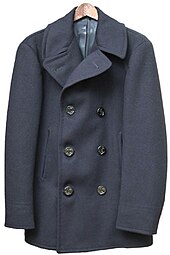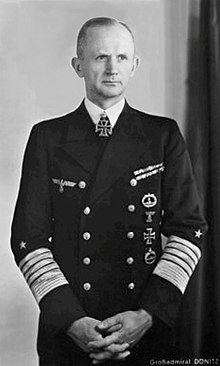Pea coat

A pea coat (or pea jacket, pilot jacket) is an outer coat, generally of a navy-colored heavy wool,[1] originally worn by sailors of American and European navies.[2] Pea coats are characterized by broad lapels, double-breasted fronts, often large wooden or metal buttons, and vertical or slash pockets.[3] References to the pea jacket appear in American newspapers at least as early as the 1720s,[4] and modern renditions still maintain the original design and composition.[1]
A "bridge coat" is a pea coat that extends to the thighs, and is a uniform exclusively for officers and Chief Petty Officers. The "reefer" is for officers only, and is identical to the basic design but usually has gold buttons and epaulettes.[2]
Characteristics

Today the style is considered a classic, and pea coats are now worn by all manner of individuals. When it is worn by a woman, it is often referred to as a Jackie O Jacket.
Note that few of the jackets seen on the street are genuine navy surplus; being a classic garment, it is frequently available from retailers, though often with small design changes that reflect the current fashion trends. The standard for historical pea coats was 30 ounces (approx. 850 g) wool, most often made of heavy Melton Cloth through the 1970s in the U.S. Navy. Presently coats are made from 22–32 oz (620–910 g) wool. While pea coats are offered in many colors by retailers, the U.S. Navy-issue pea coat[5] is always dark blue or black.
The term "pea coat" originated from the Dutch or West Frisian word pijjekker, in which pij referred to the type of cloth used, a coarse kind of twilled blue cloth with a nap on one side.
References
- ^ a b "US Navy-style Pea ("P") Coat". US Wings Inc. 2008. Retrieved 2007-12-31.
- ^ a b Carl Saylor (2007). "The History and Evolution of the Pea Jacket". ArticleSplash. Retrieved 2007-12-31.
- ^ Stilson, Sam (2007). "The Perfection Of The Pea Coat". The Soko. Retrieved 2007-12-31.
- ^ Boston Gazette, Iss. 22, May 9–16, 1720, p.3
